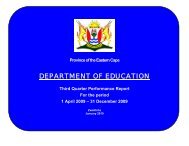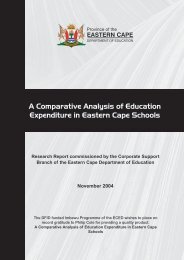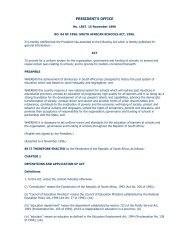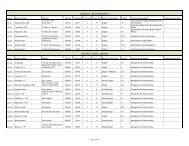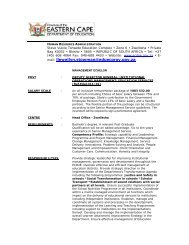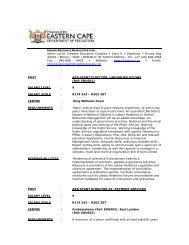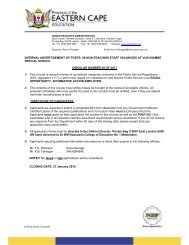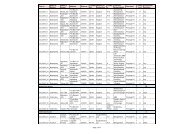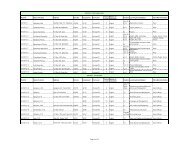part a: strategic overview - Department of Education
part a: strategic overview - Department of Education
part a: strategic overview - Department of Education
You also want an ePaper? Increase the reach of your titles
YUMPU automatically turns print PDFs into web optimized ePapers that Google loves.
establishment had been largely completed by 2001. In the four years that had elapsed<br />
changing demographics, especially from migration, and the closure and opening <strong>of</strong> schools<br />
had created new post requirements. A moratorium on new temporary and substitute teachers<br />
during the financial crisis had also limited flexibility to provide teachers where needed. In 2003<br />
there were close to 65 000 teachers in schools in the province. The De<strong>part</strong>ment <strong>of</strong> <strong>Education</strong><br />
declared an establishment <strong>of</strong> 67 074, some 2 000 above the numbers in post.<br />
During 2004 and the growing environment <strong>of</strong> financial crisis the De<strong>part</strong>ment <strong>of</strong> <strong>Education</strong><br />
concluded that this establishment was unaffordable and could not be implemented. The<br />
current 2005 educator post establishment is 63 593. After lengthy dispute with the teacher<br />
unions this establishment was declared by the MEC for <strong>Education</strong> in the first half <strong>of</strong> 2005.<br />
Redeployment and transfer is now proceeding against this establishment. The De<strong>part</strong>ment <strong>of</strong><br />
<strong>Education</strong> has also stated its intention to produce an annual educator establishment and to<br />
issue annual post bulletins for recruitment against the posts identified as vacant.<br />
Implementation <strong>of</strong> this establishment will provide both an equitable and affordable provision <strong>of</strong><br />
educators throughout the province. Based on 2005 enrolment, implementation <strong>of</strong> the educator<br />
establishment will give learner; educator ratios <strong>of</strong> 33.8 in primary school, 34.7 in combined<br />
schools, and 33.0 in secondary schools. This establishment will also lead to a more balanced<br />
distribution <strong>of</strong> personnel that will allow further recruitment <strong>of</strong> managers and administrators,<br />
especially in the districts. Some <strong>of</strong> this recruitment will be by transfer <strong>of</strong> educators that are<br />
surplus to requirements.<br />
15.5 Information Technology SYSTEMS Systems<br />
15.5.1 Information Technology Administration Systems<br />
The De<strong>part</strong>ment uses the main government transversal systems, being Persal, for salary and<br />
personnel administration; the Basic Accounting System (BAS), for commitments, payments<br />
and financial reporting services; and the Logistics System (Logis), for stores management<br />
and the issuing <strong>of</strong> orders for procurement. These systems are silo systems in that they are<br />
essentially stand alone, although there are interfaces between them. The architecture <strong>of</strong><br />
these systems has not changed over the last 30 years and they are not in keeping with the<br />
requirements <strong>of</strong> an efficient government de<strong>part</strong>ment. The De<strong>part</strong>ment uses the systems fairly<br />
extensively, except for Logis which is only effectively being used at head <strong>of</strong>fice and in the<br />
Uitenhage district.<br />
The National Treasury is the owner <strong>of</strong> these systems and they are continuing with their<br />
Integrated Financial Management System (IFMS) strategy that aims to provide integrated<br />
system to provide for transaction processing and management information in the functional<br />
areas <strong>of</strong> human resource management, supply chain management, and financial<br />
management. This strategy has been in place for at least five years and there is no definite<br />
time frame for the delivery <strong>of</strong> new systems.<br />
A critical issue is that is limiting the development <strong>of</strong> systems is the fact that section 17.3.1 <strong>of</strong><br />
the Treasury Regulations states that “Institutions may not amend existing or institute new<br />
computerised systems that will affect financial administration without the prior written approval<br />
<strong>of</strong> the National Treasury.” In implementing this provision the National Treasury is restrictive in<br />
that it rarely approves the use <strong>of</strong> new systems, due to the development <strong>of</strong> IFMS. A more<br />
flexible approach to the administration <strong>of</strong> this regulation is desperately needed to breathe new<br />
life into the ability <strong>of</strong> de<strong>part</strong>ments to ensure that their statutory obligations can be met.<br />
For example, the De<strong>part</strong>ment <strong>of</strong> <strong>Education</strong> wishes to use the Procure-to-Pay system, which<br />
has been developed by the De<strong>part</strong>ment <strong>of</strong> Social Development, and which has received<br />
international acclaim for innovation. Yet the National Treasury continues to place obstacles in<br />
the path <strong>of</strong> other de<strong>part</strong>ments wishing to use the same system.<br />
The De<strong>part</strong>ment is actively involved in procuring a supply chain management system that will<br />
assist with the reporting requirements <strong>of</strong> the Preferential Procurement Policy Framework Act<br />
5 Year ECDoE Strategic Plan for 2005/06 to 2009/10. March 2006 Page 100<br />
5 Year ECDoE Strategic Plan for 2005-06 to 2009-10. 21 F (5) Page 96<br />
<strong>part</strong> C: background information



